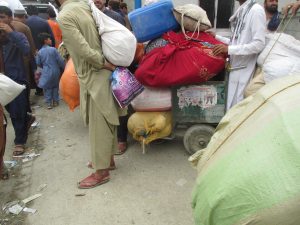Shanthie Mariet D’Souza

The unrelenting season of forced homecoming continues for Afghans who had sought refuge in neighboring countries in the past. Thousands of Afghan refugees have been forcefully relocated from countries like Pakistan, Iran, Turkey, and Tajikistan, back into Afghanistan. In a country where the current set of rulers has had little to offer other than regressive policies over the past 29 months to its citizens, these men, women, and children will find it difficult even to survive without an immediate increase in international attention and assistance.
In the erstwhile conflict-affected Afghan Republic as well as the state now controlled by the Taliban, displacement of Afghans was almost a given. Fear of persecution, natural disasters, and the search for better avenues in life combined to make, according to an estimate, 5.9 million Afghans into either internally displaced persons (IDPs) within the country or refugees abroad in the years since 2001. In the past year, however, Afghanistan’s neighbors have engaged in concerted efforts to send Afghans back – to a state that has little to offer them.
There is no single reason why the tolerance shown by host governments, many of them neighbors, for years has begun to taper off.
For Pakistan, which started a massive and well-publicized eviction drive targeting Afghan refugees in September 2023, it was possibly a way to pressure the Taliban to act against the Tehreek-e-Taliban Pakistan (TTP), which the Pakistani government alleges has found shelter in Afghanistan. Iran, too, wishes to exert pressure on Kabul to seek concessions on a host of demands including sharing of Helmand River water.
Tajikistan, the poorest of the former Soviet republics in Central Asia, hosts many Tajik Afghans en route to Canada. It has deported some non-Tajik Afghans back to Afghanistan.
For Turkey’s government, deporting Afghans may be a question of getting rid of too many refugees. Turkey, according to a 2022 estimate, hosts the largest number of refugees of any country in the world, an estimated 3.9 million people: 3.6 million Syrians with temporary protection and 320,000 others, mostly Afghans. Like Tajikistan, Turkey serves as a key passage for Afghan migrants seeking to reach Europe, with most of them entering Turkey by crossing the country’s borders with Iran.
Strategic objectives have often triumphed over humanitarian concerns. Feeble pleadings by human rights organizations and U.N. agencies have been ignored by these countries as they employ a variety of ways to get rid of the unwanted – and the refugees themselves become pawns and scapegoats. While Pakistan began deportations under a self-created media glare, Turkey pushed many Afghans into Iran, taking advantage of the unmonitored border. It also sent them back on special flights, largely ignoring the legalities and their legitimate claims to refugee status.
The net result of this is that Afghanistan now hosts over 500,000 returning Afghans, including 456,900 who returned from Pakistan between September 15 and December 9, 2023. Over 80 percent of these returnees are estimated to be women and children. These numbers also include Afghans who are essentially foreigners in Afghanistan, having been born and raised in countries that no longer accept them. Most do not have homes of their own and have been forced to live in cramped rented accommodations upon return. More will be added to the total in the coming weeks and months.
In a country where women are mostly confined to their households, girls are denied education, access to health facilities is almost non-existent, and employment opportunities are scarce, the survival of these 500,000 people in the coming harsh winter months is a huge challenge. The Taliban, which realize their inability to take care of these refugees, have asked for a halt to the deportations, but to no avail. The provincial Taliban administration in Jalalabad and aid agencies provided money, sacks of rice, and flour to some of the returning Afghans. But those supplies quickly ran out.
Traditionally, Afghans have depended upon charity and help from fellow Afghans in times of crisis. Even those traditional practices of solicitude have come under immense stress as poverty and hopelessness spread rampantly in the country. In December 2023, a group of nine international NGOs operating in Afghanistan urgently called on the international community and humanitarian donors to increase their support so that these Afghans can be fed and protected from the vagaries of nature.
The world’s attention, hence, must turn to the plight of these refugees. The international community bears a significant amount of responsibility for the prevailing state of affairs in Afghanistan. The mismanaged Doha deal, the hastened withdrawal of the U.S. and NATO forces, and the sense of detachment with which the country has been dealt with in the past two and half years are some of the factors for the series of crises that have befallen common Afghans.
Countries that host Afghan refugees should stop forcing them out, but the 500,000 who have already returned must be provided the basic essentials like food and shelter. NGO-led assistance programs can be a stop-gap arrangement in this regard. In the medium to long term, the Taliban regime needs to be engaged to help Afghanistan’s economy recover and attend to this immense refugee crisis.
No comments:
Post a Comment